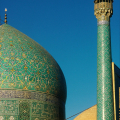GRAND MOSQUE OF THE IMAM (MASJED-E EMAM)
Architectural masterpiece, commissioned at the beginning of the seventeenth century by the Shah Abbas, this wonder of safavide art covered with blue ceramic tiles (kächi) similar to turquoises in the Khorassan region, is the most sumptuous monument left by the founder of the Abbasian dynasty. sides. The Cheik Lotfollâh mosque seemed to be too small! Built in 1611, it will only be completed after the death of its founder, despite the eagerness of the founder to work the architects night and day. It is in particular to save time that the decorations of the decorations are not, as in the other buildings of the same time, mosaics of terracotta terracotta, but colored tiles assembled to create the final drawing. And the aesthetics of Muslim art can detect many defects due to the haste of craftsmen.
Mosque of courtyard and apparel, the Shah mosque fits perfectly into the splendid imperial ensemble of the square although, beliefs oblige, it could not be built on the north-south axis but slightly oblique, which explains the uniqueness of the plan developed with a portal of bias over the rest. of the southwest-oriented building towards Mecca. But, once returned, the plan remains the same as in other Iranian mosques.
The huge entrance portico (27 m high) is framed with two very narrow minarets (42 m high). Magnificent illustration of the monumental architecture, it combines the decorative elements mixing with glazed and stalactite fade, in the image of the interior of the arc of its half-dome. Raise your head to the sky to appreciate ornamental wealth. See in particular the wonderful white arabesques and gold on the blue background on the outer wall of the portal. The large fry of silligraphy calligraphed on cobalt blue background is equally remarkable.
Once in the large inner courtyard, beyond the portico, note the four huge iwan, top vaulted rooms, open on one side. Overlooking the large prayer hall and the whole, rises the huge dome (52 m high) to the majestic bulb with turquoise varnished earthenware. Have fun under the dome to check the exceptional acoustics of the places (you must be able to hear 7 times the echo of your voice!) and admire the hypnotic arch. One of the arcades of the East iwan opens on a madrasa (Koranic school) located behind the central courtyard of the mosque. Like Iranian madrasas, it is centered around a rectangular courtyard surrounded by cells for students. The southwest wall, cobalt blue and saffron yellow, is also remarkable. In recent years, Madrasa has been home to a courageous photographic exhibition dedicated to the Muslim victims of terrorism worldwide. Throughout the day, Imams are also present to discuss and answer theological (not political) questions of visitors to inform their knowledge of Islam. With a steep door, after a tip left to the guard, the spiral staircase leads you to the base of the big dome. Ispahan then extends to your feet. Beyond the Place de l 'Imam, the ostracized ochre city of turquoise coughing deploys its charms on a backdrop of mountains… Nevertheless, to enjoy the view of the Imam mosque, go to the upper floor of the Ali Qâpu pavilion also located on the square.
Did you know? This review was written by our professional authors.
Members' reviews on GRAND MOSQUE OF THE IMAM (MASJED-E EMAM)
The ratings and reviews below reflect the subjective opinions of members and not the opinion of The Little Witty.










cet ensemble unique mérite une longue visite.